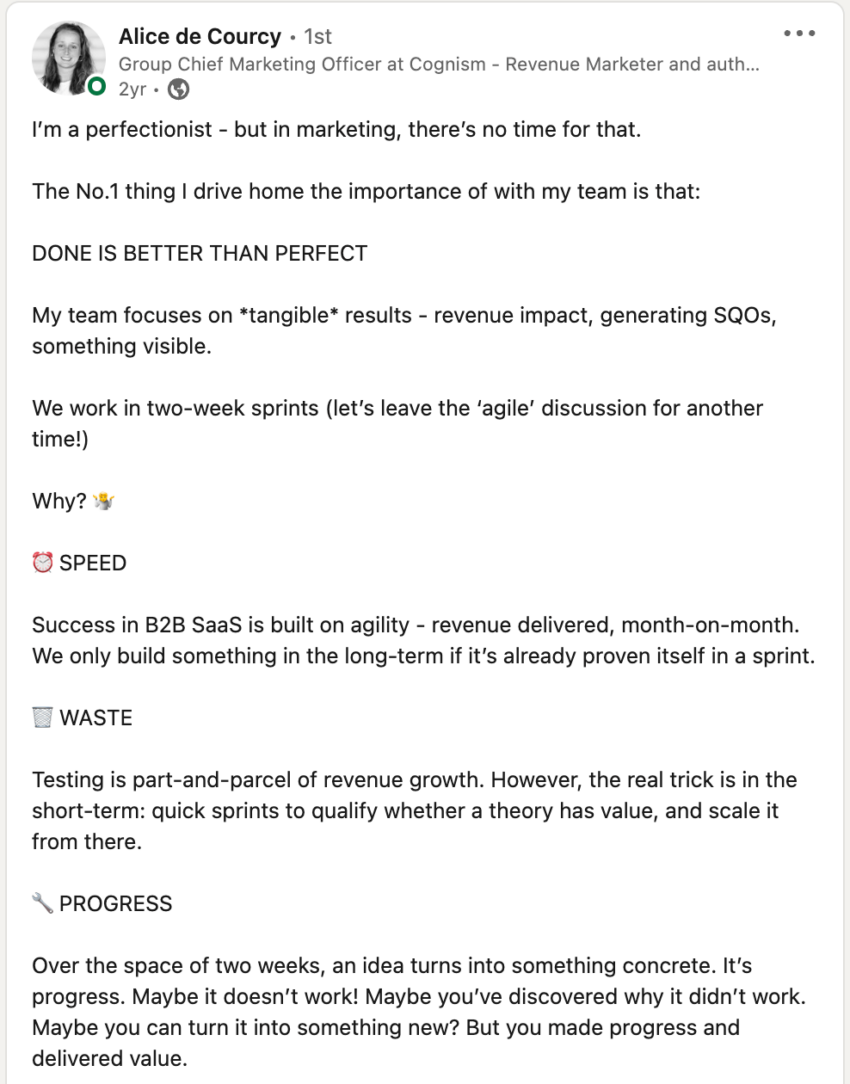The Diary of a First-Time CMO: Done is Better Than Perfect
Note: The following is an excerpt from The diary of a first-time CMO by Alice de Courcy. It covers the key learnings she gathered in four years of leadership. This diary reveals the lessons that helped de Courcy scale Cognism from $3m to $50m ARR, build a team from 3 to 39, and transform their set-up from a classic lead gen function to a demand gen engine. It’s a handbook for B2B marketers looking to thrive in leadership.

Ever felt decision paralysis when faced with a big question, with no immediate clear answer?
I think it’s pretty common. In my experience, lots of marketers find themselves frozen by fear by the age old question:
‘How will we scale this?’
Just because there’s no one single right answer.
I firmly believe that our competitive advantage at Cognism has been the ability to move quickly, and be one of the first in our industry to make bold moves.
I consider myself to be an action-biassed CMO and believe that an idea is only as good as its execution. I live and breathe this philosophy every day and it’s instilled within my team.
Right now we are recreating the way B2B marketing implements demand generation and – as with anything involving stepping out into new territory – there’s no instruction manual.
We don’t always have all the answers. But we can’t let that stop us from making progress.
We continue to test and experiment new ways of creating demand and running campaigns, even if we don’t yet have the perfect formula for measuring all of its impact.
We look for trends, we look for correlations and we collect all the data we have to make informed decisions.
It is not perfect by any means, but it’s transformed our business. Moving us off the MQL hamster wheel and delivering record breaking revenue and pipeline months.
If we were still waiting for the perfect way to measure the impact, we wouldn’t be as far along as we are today.
Of course when there’s so much going on, it helps to have something to manage our workflows.
We run bi-weekly sprints using Asana as our project management tool. We have boards for projects that each team is responsible for and we set milestones and KPI’s against them.
By tracking projects in this way and by ensuring a regular cadence for reporting on the outcomes, it’s very clear where the priorities need to be.
That’s the purpose of the sprint. It’s a dedicated time for us as marketing leaders to scrutinise the team’s workload and focus within the context of the big picture reporting.
These insights help us to decide which activities to continue, divert or stop, depending on where our focus needs to be directed.
One of the signals we look for is increased output – it’s very easy to track this if you use a project management tool like Asana and this certainly was the outcome for us when we started to work in the sprint methodology.
It’s helped us to evaluate those ‘because we have always done them’ tasks too. This method is one of the key ways in which we were able to shine a light on these types of activities and re-evaluate their utility in relation to the results.
Another benefit is the overall transparency into the team’s workload and activities. You can clearly identify any ‘busy work’ from value-adding work that should be prioritised.
In the early days you don’t know what is going to work. Even if you are a very experienced CMO, you don’t know what will work for this unique ‘coming together’ of ICP, product, market fit, stage, team and more.
So you need to start to work this out fast. This is one way I’ve found to help me do that.
Your experience will give you a good steer on where to start out experimenting and how to do it well, but building and getting things live quickly in the early days can definitely be your competitive advantage.
Alice de Courcy is the Group Chief Marketing Officer at Cognism. She is an experienced B2B SaaS marketing leader specialized in enabling SaaS companies and startups accelerate their growth.